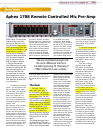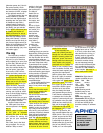
If someone says the word
“Aphex,” your first response will
likely be,”Aural Exciter,”right?
Yes, that piece is the thing most
of us associate with the Sun
Valley, Calif. company, but if
there is a shred of justice out
there in the big wide world, that
exchange will soon go like this:
“Aphex?””I788.”
Marvin Caesar, Aphex presi dent,
has been bending ears for a
while now about the effects of
long mic lines and splitters on a
system in terms of both loading
and degradation of sound quali ty.
He has been an evangelist for
the idea of mic-pre’s that live as
close to the source as possible
to overcome the problem. (BTW,
that is the same approach the
Yamaha PM1 D, the DiGiCo
D5
and the digitally controlled
Showconsole use, given the fact
that the pre’s are separate from
the control surface anyway.)
Like many of you, we listened
with interest until we realized
that what he was proposing
meant not using the beloved
pre’s in our favorite consoles,
which is
the point at which most
of our eyes glaze over and we
start thinking of possible reasons
he could be wrong. Well, he’s
right.
for the MON (Aux) output.
The optional digital module
con sists of a 15-pin D-Sub for
the AES, a TDIF D-sub and a
Toslink for the ADAT, and two
BNCs for word clock in and
out.The con trol connectors
are MIDI In,Thru and Out, RS-
232, RS-422 In and RS-422
Link Out.While these control
connec tions are computer-type
RS422 and 232 connectors,
Aphex pro vides a cool little
serial/XLR adapter that
allows you to run the RS-422
remote signal over a couple
of unused snake chan nels.
Control of multiple units is
made by daisy-chaining via
the RS-422 from unit to unit.
Aphex provided a hardware
remote for this review, but
as setup time on our gig was
limited, we opted not to use
it. I had the advantage of a
short tutorial at Aphex prior to
the gig, and Paul would have
been approaching the system
cold. So we decided that I
would control the units from
MON, rather than having Paul
control them from FOH. (Aphex
says that when many units
are linked together via serial
control, the system can be
sluggish. Aphex has developed
a new control system that uses
LAN technolo
gy over CAT5.
The speed of con trolling 16
Aphex 1788 Remote Controlled Mic Pre-Amp
“He was impressed enough with
the sonic difference that he is
considering buying 24 channels of
1788s instead of a new console. “
The Gear
(Editor’s Note: This may be the
toughest review I have ever
had a part in. Because, to be
very plain spoken, l have never
used a single piece of gear that
made this much difference in the
overall sound of a system, and
it will be hard to write about it
without sounding like an Aphex
shill. So please understand
going in that Aphex did not
write the review or influence
it. They got the same fact
check opportunity as any other
company, but noth ing else. We
even returned the gear in just
72 hours-far less time than
we usually take. No money or
gear changed hands, and at
this point, Aphex is not even an
FOH advertiser. Now that that
is out of the way...)
units is the same as controlling
one of the old units The totally
new software is PC and MAC
compatible.)
It is all solid and well built.
The only complaint would be
the aforementioned crowding on
the back panel-pulling a single
XLR connector after everything
was plugged in was a bit of a
challenge for those of us with
stubby fingers.
From left to right on
the front panel are eight
LED ladders for monitoring
headroom, with a numbered
push-button under each for
activating con trol of that
channel. Surrounding the
meters are indicators for Input
Gain (switchable to FOH and
MON output levels), mute,
phantom power,-26 dB pad,
70 Hz LoCut, polarity reverse
and the limiter (one of the
unit’s coolest and most useful
features). Next to the channel
buttons is a switch that allows
you to choose multiple channels
to control at the same time.
(Note that when adjusting
gain on multiple chan nels,
the changes are relative. In
other words if there was a
6dB difference in the channels
to begin with, that difference
will remain as gain is raised
or low ered.) Surrounding the
single gain knob are switches
to choose between gain stages
(input and output for both FOH
and MON) and the switches for
the options mentioned earlier
The Aphex 1788 is a
pretty neat piece of gear. In
two rack spaces, you get eight
channels of mic pre’s complete
with a splitter. Stock, the units
provide separate analog outs for
FOH and MON, and the optional
digital out provides simultane ous
digital streams in TDIF, AES/EBU
and ADAT LightPipe formats.
Note that all three digi tal outs
are active at the same time.
Recording resolution can be as
high as 96 kHz in the AES/EBU
stream and 48 kHZ with the
others.
The crowded back panel has a
mic input XLR and FOH (Main)
output XLR for each channel, and
a 25-pin D-sub (Tascam format
)




